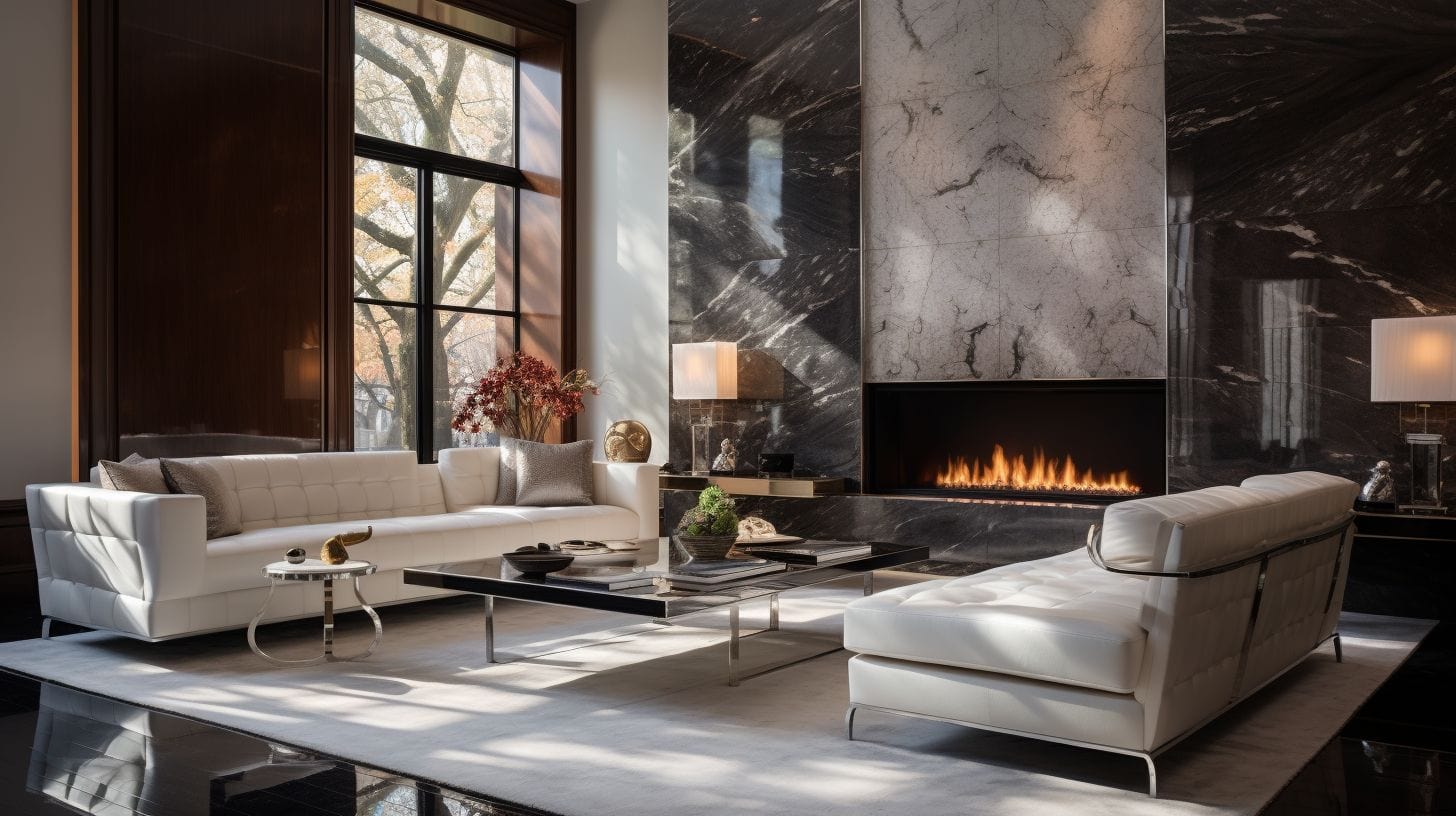Venetian plaster, renowned for its luxurious and timeless appeal, has been a favoured choice in interior design for centuries. Originating from ancient Roman techniques, this decorative finish creates a stunning, marble-like effect that adds elegance and sophistication to any space.
High-Gloss Elegance: Polished Venetian Plaster
Polished Venetian plaster stands out among other finishes for its smooth, high-gloss surface that reflects light beautifully, creating an illusion of depth and space. This finish not only enhances the visual appeal of interiors but also provides a durable and easy-to-maintain surface.
In this article, we explore the unique characteristics of polished Venetian plaster, delve into the techniques for achieving its signature shine, and discuss the best surfaces and applications for this exquisite finish.

Characteristics of Polished Venetian Plaster
Composition: Lime, Marble Dust, and Water
Polished Venetian plaster is composed of three primary ingredients:
- Lime: This is the base material, providing the plaster with its natural breathability and antimicrobial properties. Lime has been used in plastering for centuries due to its durability and versatility.
- Marble Dust: Finely ground marble dust is mixed with the lime to give Venetian plaster its distinctive texture and reflective quality. The marble dust enhances the plaster’s ability to achieve a polished, glossy finish.
- Water: Water is used to mix the lime and marble dust into a workable paste, ensuring the plaster can be applied smoothly and evenly.
Distinctive Features: Smooth, Glossy Finish
The hallmark of polished Venetian plaster is its smooth, high-gloss finish. This effect is achieved through meticulous application and burnishing techniques that create a surface reminiscent of polished marble. The plaster’s reflective quality adds depth and luminosity to walls, making spaces appear larger and more open.
Advantages: Aesthetic Appeal and Durability
Polished Venetian plaster offers several key advantages:
- Aesthetic Appeal: Its luxurious, marble-like finish makes it a popular choice for high-end residential and commercial interiors. The high-gloss surface enhances the visual impact of any space, creating a sophisticated and elegant atmosphere.
- Durability: When properly applied and maintained, polished Venetian plaster is highly durable and resistant to minor impacts and abrasions. Its natural composition also makes it less susceptible to mould and mildew, contributing to a healthier indoor environment.
- Low Maintenance: The smooth surface of polished Venetian plaster is easy to clean and maintain. Regular dusting and occasional wiping with a damp cloth are typically sufficient to keep it looking pristine.
Techniques for Achieving a High-Gloss Finish
Surface Preparation
Cleaning and Priming
Achieving a flawless high-gloss finish begins with meticulous surface preparation. Ensure the surface is clean, dry, and free from any contaminants such as dust, grease, or old paint. Proper cleaning ensures that the plaster adheres correctly and achieves a smooth finish.
- Cleaning: Remove any existing coatings and thoroughly clean the surface to eliminate dirt and debris.
- Patching and Repairing: Address any imperfections, such as cracks or holes, with appropriate fillers to create a smooth, even base.
- Priming: Apply a suitable primer that is compatible with Venetian plaster. Priming enhances the plaster’s adhesion and durability.
Layering Process
Application of Multiple Thin Layers
Polished Venetian plaster requires the application of multiple thin layers to build up the desired depth and sheen.
- First Layer: Apply a thin base coat using a stainless steel trowel. Use broad, smooth strokes to ensure an even application. Allow this layer to dry partially before proceeding to the next.
- Subsequent Layers: Continue applying additional thin layers, each one slightly thicker than the previous. Each layer should be smoothed out meticulously to avoid any texture that could interfere with the final polish.
Burnishing Methods
Timing and Tools
Burnishing is the key to achieving the high-gloss finish characteristic of polished Venetian plaster. The timing of this process is crucial; it should be done while the plaster is still slightly damp but firm to the touch.
- Tools: Use a clean, stainless steel trowel or a specialised burnishing tool. The smoothness and cleanliness of the tool are essential to avoid scratches and imperfections.
- Technique: Apply firm, even pressure with the trowel, using smooth, overlapping strokes. This friction generates heat, which helps to polish the plaster and bring out its natural lustre. Burnish each layer until you achieve the desired level of gloss.
Additional Polishing Techniques
Use of Fine Grit Sandpaper
For an even more refined finish, you can lightly sand the surface with fine grit sandpaper (around 400-600 grit) between layers. This helps to eliminate any minor imperfections and enhance the smoothness of the final finish.
Application of Wax or Soap for Extra Gloss
To achieve an extra glossy finish, apply a fine layer of wax or special polishing soap after the final layer has dried.
- Wax Application: Use a soft cloth to apply a thin, even layer of wax. Buff the surface with a clean cloth or a power buffer to enhance the shine.
- Soap Application: Apply a special polishing soap with a trowel, then burnish the surface again to achieve a deep, lustrous finish.

Best Surfaces for Polished Venetian Plaster
Ideal Substrates
Drywall
Drywall is one of the most common substrates for polished Venetian plaster. Its smooth and flat surface makes it an excellent base for achieving a flawless finish. Ensure the drywall is properly primed to enhance the plaster’s adhesion and durability.
Plasterboard
Similar to drywall, plasterboard provides a stable and even surface suitable for Venetian plaster. The preparation process for plasterboard involves cleaning, patching any imperfections, and applying a primer compatible with the plaster.
Cement-Based Surfaces
Cement-based surfaces, such as concrete or cement board, are also ideal for Venetian plaster. These substrates offer excellent durability and support for the plaster. Proper surface preparation, including cleaning, patching, and priming, is essential to ensure the plaster adheres correctly and achieves the desired finish.
Unsuitable Surfaces
Surfaces Prone to Moisture
Avoid applying polished Venetian plaster to surfaces that are constantly exposed to moisture, such as unsealed bathrooms or kitchens without adequate ventilation. Excessive moisture can compromise the plaster’s integrity and lead to issues like peeling or mould growth.
Highly Textured or Uneven Surfaces
Surfaces with significant texture or unevenness are not suitable for polished Venetian plaster. The plaster’s high-gloss finish requires a smooth and even base to achieve the desired look. Textured or uneven surfaces can create imperfections and disrupt the smooth, polished appearance.
Preparing the Surface
Ensuring Smoothness
Regardless of the substrate, achieving a high-gloss finish requires meticulous surface preparation. Fill any cracks, holes, or imperfections with appropriate fillers and sand the surface to ensure it is smooth and even. Priming the surface with a suitable primer is also crucial to enhance the plaster’s adhesion and performance.
Common Applications and Uses
Residential Spaces
Living Rooms and Dining Areas
Polished Venetian plaster adds a touch of luxury and sophistication to living rooms and dining areas. Its high-gloss finish reflects light beautifully, creating an inviting and elegant atmosphere. The plaster’s versatility allows it to complement a variety of interior design styles, from classic to contemporary.
Bathrooms and Kitchens
In bathrooms and kitchens, polished Venetian plaster provides a durable and moisture-resistant surface that is both functional and visually stunning. The smooth, glossy finish is easy to clean and maintain, making it an ideal choice for these high-traffic areas. Ensure proper ventilation and sealing to maintain the plaster’s integrity in moisture-prone environments.
Commercial Spaces
Hotels and Restaurants
Polished Venetian plaster is a popular choice in the hospitality industry, where it enhances the ambiance of hotels and restaurants. Its luxurious appearance creates a memorable experience for guests, while its durability ensures it can withstand the wear and tear of busy commercial settings. The ability to customise colours and finishes allows for unique and personalised designs.
Offices and Showrooms
In office spaces and showrooms, polished Venetian plaster exudes professionalism and elegance. It can be used to create striking feature walls or to add a refined touch to conference rooms and executive offices. The high-gloss finish not only elevates the aesthetic appeal but also enhances the perceived value of the space.
Artistic and Decorative Uses
Accent Walls
Polished Venetian plaster is perfect for creating accent walls that serve as focal points in any room. Its glossy, reflective surface draws attention and adds a layer of sophistication to the overall design. Accent walls can be used in both residential and commercial settings to make a bold design statement.
Artistic Installations
Beyond traditional wall applications, polished Venetian plaster can be used for artistic installations and decorative elements. Its versatility allows artists and designers to explore creative possibilities, from intricate patterns and textures to custom colours and finishes. These installations can transform ordinary spaces into works of art.
Maintenance and Care
Regular Cleaning
Dusting and Gentle Wiping
Polished Venetian plaster requires minimal maintenance to retain its luxurious appearance. Regular dusting with a soft, dry cloth helps keep the surface free of dust and debris. For more thorough cleaning, gently wipe the surface with a damp cloth. Avoid using abrasive cleaners or tools, as they can scratch the glossy finish.
Periodic Maintenance
Reapplying Wax or Polish
To maintain the high-gloss finish, periodic reapplication of wax or a suitable polish is recommended. This process not only enhances the shine but also provides a protective layer against dirt and moisture.
- Wax Application: Apply a thin, even layer of wax using a soft cloth. Buff the surface with a clean, dry cloth or a power buffer to restore the shine.
- Polish Application: Use a specialised polish designed for Venetian plaster. Follow the manufacturer’s instructions for application and buffing to achieve the desired gloss.
Repairing Minor Imperfections
Despite its durability, polished Venetian plaster may occasionally develop minor imperfections such as small scratches or chips. These can be repaired relatively easily:
- Small Scratches: Lightly sand the affected area with fine grit sandpaper (around 400-600 grit) and reapply a thin layer of plaster if necessary. Burnish the area to blend it seamlessly with the surrounding surface.
- Chips and Cracks: Fill any chips or cracks with a matching plaster mixture. Once dried, sand the area smoothly and reapply the final layers of plaster, followed by burnishing to restore the high-gloss finish.
Protecting the Surface
Avoiding Harsh Chemicals
Avoid using harsh chemicals or abrasive cleaners on polished Venetian plaster. These substances can damage the finish and diminish its glossy appearance. Instead, opt for mild, pH-neutral cleaners and soft cleaning tools.
Preventing Physical Damage
To preserve the pristine condition of polished Venetian plaster, take measures to protect it from physical damage. Avoid placing heavy objects or sharp items against the plastered walls. In high-traffic areas, consider using protective barriers or coverings to minimise the risk of accidental damage.
Conclusion
Achieving Lasting Elegance with Polished Venetian Plaster
Polished Venetian plaster, with its exquisite high-gloss finish, remains a sought-after choice for adding luxury and sophistication to interiors. Its unique composition of lime, marble dust, and water creates a durable, reflective surface that enhances the aesthetic appeal of any space.
Mastering the Art of High-Gloss Finishes
Achieving a polished Venetian plaster finish requires meticulous attention to detail during the application process. From thorough surface preparation and precise layering to expert burnishing techniques, each step is crucial in creating the signature glossy effect. The addition of fine grit sanding and waxing or polishing can further enhance the final result, ensuring a deep, lustrous shine.
Versatile Applications and Lasting Appeal
The versatility of polished Venetian plaster allows it to be used in a wide range of settings, from residential living rooms and bathrooms to commercial hotels and restaurants. Its ability to transform ordinary walls into works of art makes it a popular choice for accent walls and artistic installations. Moreover, the low maintenance and high durability of polished Venetian plaster ensure that its beauty endures over time with minimal effort.
Preserving the Timeless Beauty
Maintaining the elegance of polished Venetian plaster involves regular cleaning, periodic waxing, and careful protection from physical damage. By following these maintenance practices, homeowners and designers can enjoy the timeless beauty and sophistication that polished Venetian plaster brings to any interior.
Polished Venetian plaster not only elevates the aesthetic of spaces but also reflects a commitment to quality and craftsmanship. Its enduring appeal and luxurious finish continue to make it a preferred choice for those seeking to create visually stunning and elegant interiors.
Achieve High-Gloss Finishes with Polished Venetian Plaster from Venetian Plasterer
At Venetian Plasterer, we specialise in creating stunning high-gloss finishes with polished Venetian plaster for our Sydney clients. Our expert team uses advanced techniques to achieve a perfect shine, enhancing the beauty and elegance of your interiors. We carefully select the best surfaces for application to ensure optimal results, transforming your walls into works of art. With our high-quality Sydney Venetian plaster services, you can enjoy a durable, luxurious finish that adds sophistication and value to any space.
Related
Polishing Techniques for Venetian Plaster: Special Tools, Polishing Compounds and Waxes, Safety Tips

